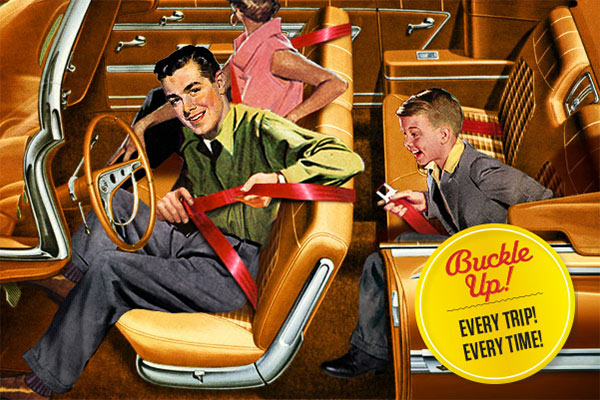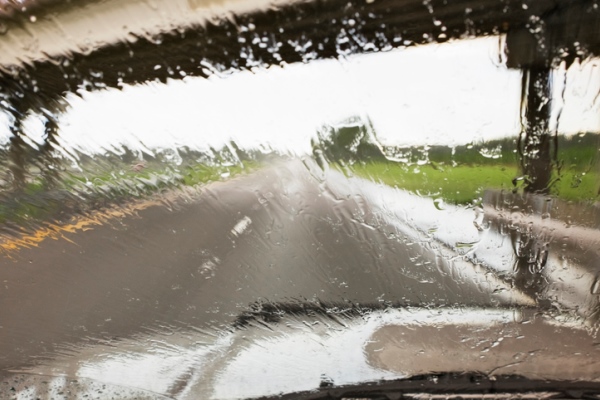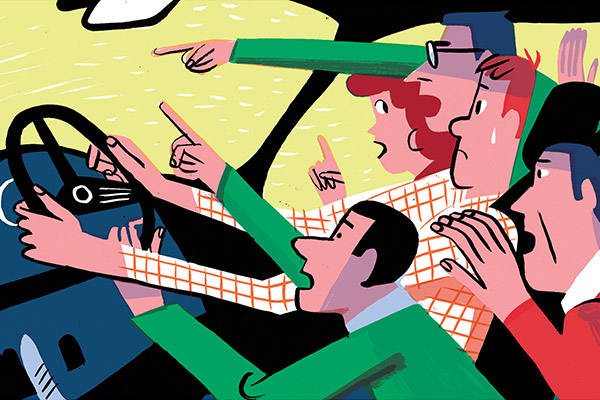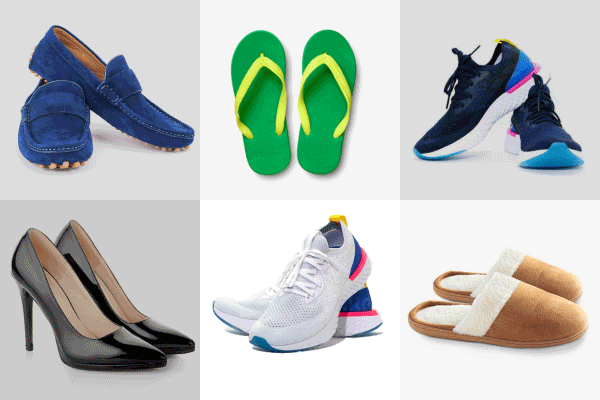Seat belts reduce serious crash-related injuries and deaths by about half, according to the National Highway Traffic Safety Administration. The simple act of wearing a seat belt is the single most effective way to reduce the risk of fatality in a crash. So why do millions of people not buckle up on every trip? Let’s debunk five common myths about wearing seat belts that are outdated or just plain wrong.
5 Common Misconceptions About Seatbelts
#1: Seat belts are uncomfortable and restrict my movement.
Wearing a seat belt should not cause any discomfort or pressure when adjusted properly. Seat belts have come a long way in the comfort department since becoming a mandatory feature in cars in the 1960s. Technological advancements like polyester webbing and pretensioners, which eliminate slack in the event of a crash, have made seat belts more comfortable for the wearer. If you want to customize your fit, you can find clips and extenders at your local dealer or auto parts store.
With children, the shoulder belt should fit across the shoulder and chest, and the vehicle lap belt should fit across the upper thighs. (Children are typically between the ages of 8 and 12 years old when they are ready for a seat belt. A good test is if their knees bend at the edge of the seat when backs and bottoms are pressed against the vehicle seat back.)
Pregnant women should wear both the lap belt and the shoulder strap, ensuring a snug fit. Lap belts should be buckled under the belly and over hips. Never place the lap belt across your belly. The shoulder strap should go between the breasts and off to the side of the belly. Never place the shoulder strap under the arm.
#2: Seat belts trap you in your vehicle during a crash.
This myth is often associated with fire- and water-related accidents, which account for less than one-half of one percent of all crashes. More importantly, seat belts can actually prevent you from being knocked unconscious, which can increase your chances of escaping during an accident.
#3: I’m just going up the block for groceries. I don’t need to wear a seat belt around town.
Think again. Routine, seemingly low-key trips can be deceptively dangerous. Did you know that most traffic-related deaths happen within 25 miles from your house and at speeds less than 40 mph, according to the National Highway Traffic Safety Administration? Don’t take any chances. Your life and the lives of your passengers are at stake.
#4: I don’t have time to put on my seat belt.
It only takes about three seconds to strap on your seat belt. That’s less time than it takes to tie your shoe. Even if you’re buckling up 20 times a day, that’s only one minute of your day.
#5: My car has air bags, so I don’t need to wear a seat belt.
Air bags are designed to protect a buckled passenger, not an unbuckled one. Seat belts secure you in the proper position to benefit from an air bag deployment. If you’re not wearing your seat belt, you’re in danger of sliding underneath the air bag, colliding with the dashboard or windshield, or being ejected from the front seat. Air bags are a supplemental form of protection and most are designed to deploy in moderate-to-severe frontal crashes, which doesn’t cover all situations. Using air bags in conjunction with seat belts is your best bet.
The History Of Seatbelts
 Forget statistics, campaigns or pleas from car manufacturers. As the history of the seatbelt shows, the most effective way to get drivers and passengers to buckle up is to hit them where it hurts: in their wallets.
Forget statistics, campaigns or pleas from car manufacturers. As the history of the seatbelt shows, the most effective way to get drivers and passengers to buckle up is to hit them where it hurts: in their wallets.
Although lap belts were offered in cars as early as the 1950s, they were snubbed by many until 1984, when New York became the first state to crack down on car safety. “The thing that started to get people to buckle up in large numbers was simply having state laws with a minimal fine of $25 or $50 for not buckling up,” says Mike Ciccone, senior director of crashworthiness evaluations at Insurance Institute for Highway Safety (IIHS).
The importance of using seatbelts is no joke. No other quick daily habit—not even eating your veggies—has such life-changing benefits. “Lap and shoulder belts are about
50 percent effective in preventing fatal injuries to front‐seat occupants in crashes of all kinds,” says Ciccone. The numbers are staggering: Safety belts saved 12,802 lives in 2014, according to the National Highway Traffic Safety Administration (NHTSA). Compare that with the early 1980s, when just roughly 11 percent of front-seat passengers wore belts. So when did people buckle down on buckling up? Here, a look back at the invention, technology and laws behind seatbelts.
1885: The U.S. Patent Office issues the first seatbelt patent.
1949-50: Nash Motors Company offers lap belts in certain car models.
1959: Volvo engineer Nils Bohlin invents the first three-point safety belt in Sweden by combining the lap belt and shoulder strap into one continuous belt that could be buckled with one hand. The invention’s open patent allows other manufacturers to adopt the game-changing design.
1968: The first federal law regarding seatbelts—called the Federal Motor Vehicle Safety Standards—is passed, requiring all new cars sold in the U.S. to feature lap or shoulder belts in the front seats and lap belts in the back seats.
1984: New York passes the first “primary enforcement law,” in which a police officer can pull over and ticket a driver just for not wearing a seatbelt. Thirty-four states now have primary enforcement laws, while 15 states have secondary laws, which means drivers pulled over for another reason can receive a ticket for not wearing a seatbelt. The fear of getting ticketed led to a quick jump in seatbelt usage for those states, which meant fewer deaths and injuries. People pay more attention to primary laws, and buckle up more. According to IIHS, if all states with secondary laws had primary laws instead, their passenger deaths would decrease by 7 percent.
1993: North Carolina’s “Click It or Ticket” campaign, which involved TV ads and billboards highlighting the cost of getting pulled over, dramatically increases seatbelt use from
65 percent to 81 percent. A decade later, the “Click It or Ticket” campaign goes national.
2015: States with primary enforcement laws report seatbelt usage at 91 percent, and states with secondary enforcement laws (or no law at all) report seatbelt usage at 79 percent.
Living in such a rapidly changing world, it’s easy to take innovations for granted, but remember that seatbelts were designed with one goal in mind: to protect you. Don’t forget to buckle up on your next ride—and that goes for everyone, especially kids and even pets.
You always buckle up … right? Good. GEICO offers discounts to good drivers. See how much you could save.
Next article: 5 Common Driving Myths Debunked
By Stephanie Levis and Kara Cutruzzula









Vernon S says,
Seatbelts are another safety measure that saves lives in a car.
Addison Campanella says,
So you don’t get ejected from the seat, hit your head and go unconscious and then it gives you more time to think properly and remove yourself from the vehicle.
Carron Burke says,
Seatbelts are indeed our security blanket , wearing them makes us so much more secure while driving